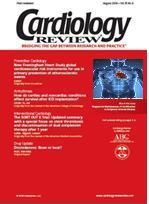Publication
Article
Cardiology Review® Online
Continuing Medical Education Exam
Target: CAD/Diabetes
From "
"
High clopidogrel maintenance dosage in patients with diabetes mellitus and coronary artery disease
Learning objectives
Discuss the clinical implications of using an increased 150-mg maintenance dose of clopidogrel compared with the standard 75-mg dose in diabetic patients who have a suboptimal response to the standard dose.
Questions
- In the OPTIMUS study, 64 subjects underwent platelet function assessment; 40 subjects demonstrated suboptimal response to clopidogrel and were randomly assigned to either 75 mg/day or 150-mg/day of clopidogrel. At study time point 2 (30 days postrandomization), the peak platelet aggregation (Aggmax) decreased to <50% in only ______ of subjects in the 150-mg group. 10% 25% 40% 60%
- Suboptimal responders were defined as those with a 20 µmol/L adenosine diphosphate-induced Aggmax of ______. < 25% 50% < 50%
- The P2Y12 reactivity ratio was ______ in the 150-mg group at study time point 2. not significantly different from the 75-mg group markedly decreased unchanged from baseline
- According to current guidelines (class IIb indication, level of evidence C), the maintenance dosage of clopidogrel may be increased to ______ for patients in whom stent thrombosis may be disastrous or fatal if < 50% inhibition of platelet aggregation is shown. 150 mg/day 250 mg/day 300 mg/day 600 mg/day
- The patient in the case study underwent percutaneous coronary intervention 6 hours after pretreatment with 600 mg of clopidogrel. The patient's platelet function was again assessed 48 hours after the procedure. The degree of inhibition of platelet aggregation (IPA) was 20%. Given the low degree of platelet inhibition and the persistence of elevated platelet reactivity using 75 mg of clopidogrel, the maintenance dose was increased to 150 mg daily. At the patient's 1-month follow-up, he had a degree of IPA of _______. 10% 35% 55.5% 72%
To take this exam, you can
. Cardiology Review materials are posted to that site on a continuous basis (registration required).
download the CME answer form (PDF) and mail, fax, or email it to address given; or go to the University of Cincinnati's Center for Continuous Professional Development
Target: Lipid Disorders
From "
"
Cholesterol fractions and heart disease mortality in older men
Learning objectives
Describe the relationship between death from ischemic heart disease and total cholesterol, cholesterol fractions, and apolipoproteins in older men.
Questions
- The importance of blood lipids in the risk of ischemic heart disease (IHD) in older people is unclear. As a result, older patients are rarely prescribed cholesterol-lowering treatment. Only ______ of the [all male] subjects in the Clarke study were receiving statin therapy when they were re-surveyed in 1997. 8% 5% 2% 1%
- According to the Clarke study, a difference of 2 standard deviations (SDs) in lipid levels is roughly equal to the mean difference between the top and bottom thirds of a normal distribution and roughly equal to the changes that can be achieved with ______. smoking cessation statin treatment for low-density lipoprotein (LDL) cholesterol combination statin and niacin therapy to increase high-density lipoprotein (HDL) cholesterol levels a rigorous exercise regimen
- The study showed that the risk of death from IHD was associated with ______ for men who had not had a previous cardiovascular disease (CVD) diagnosis, and there was a nonsignificant inverse relationship for men with prior diagnosed CVD or history of statin use. total cholesterol levels increasing HDL cholesterol and Apo A1 levels increasing LDL cholesterol and Apo B levels total/HDL cholesterol and Apo B/Apo A1 levels
- Regardless of the presence or absence of CV disease, _____ were inversely associated with IHD mortality. total/HDL cholesterol and Apo B/Apo B1 HDL cholesterol and Apo B HDL cholesterol and Apo A1 LDL cholesterol and Apo B
- Although ______ is often used to portend the risk of death from IHD in the general population, the study findings indicate that when used alone, it has the lowest predictive value. total/HDL cholesterol and Apo B/Apo A1 levels LDL cholesterol and Apo B total cholesterol level
To take this exam, you can
. Cardiology Review materials are posted to that site on a continuous basis (registration required).
download the CME answer form (PDF) and mail, fax, or email it to address given; or go to the University of Cincinnati's Center for Continuous Professional Development






